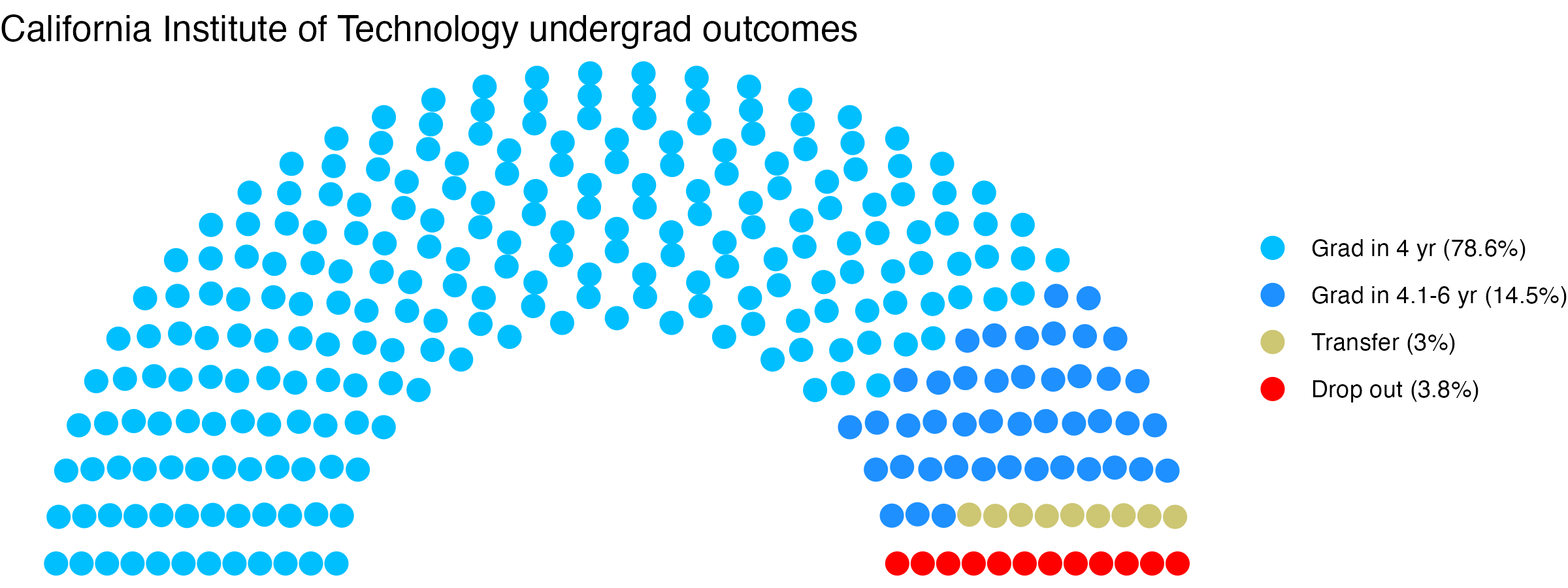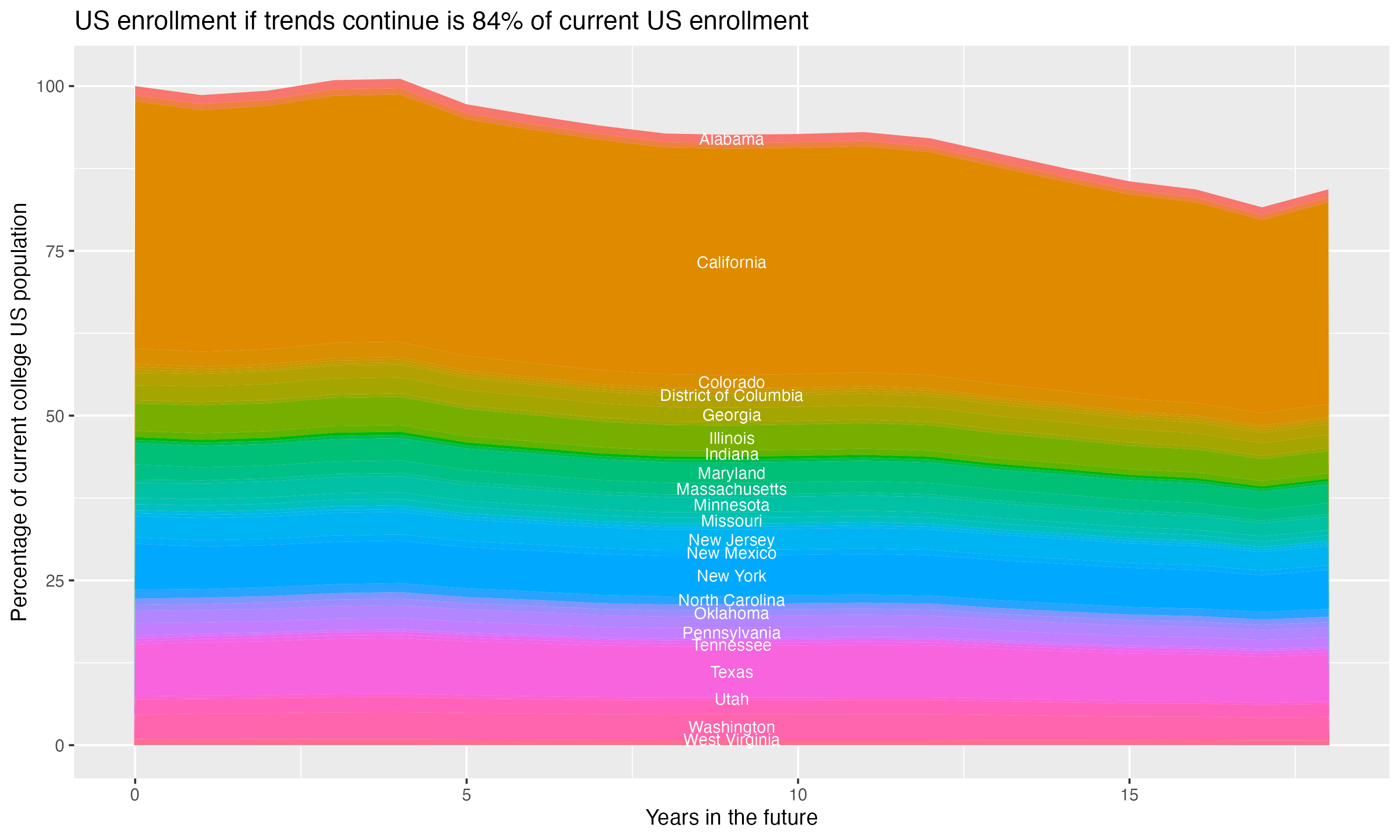California Institute of Technology
California Institute of Technology is located in Pasadena, California. It is a private not-for-profit, 4-year or above institution.
From Wikipedia: The California Institute of Technology (branded as Caltech) is a private research university in Pasadena, California, United States. The university is responsible for many modern scientific advancements and is among a small group of institutes of technology in the United States that are devoted to the instruction of pure and applied sciences. The institution was founded as a preparatory and vocational school by Amos G. Throop in 1891 and began attracting influential scientists such as George Ellery Hale, Arthur Amos Noyes, and Robert Andrews Millikan in the early 20th century. The vocational and preparatory schools were disbanded and spun off in 1910, and the college assumed its present name in 1920. In 1934, Caltech was elected to the Association of American Universities, and the antecedents of NASA’s Jet Propulsion Laboratory, which Caltech continues to manage and operate, were established between 1936 and 1943 under Theodore von Kármán. Caltech has six academic divisions with strong emphasis on science and engineering, managing $332 million in research grants as of 2010. Its 124-acre (50 ha) primary campus is located approximately 11 mi (18 km) northeast of downtown Los Angeles, in Pasadena. First-year students are required to live on campus, and 95% of undergraduates remain in the on-campus housing system at Caltech. Students agree to abide by an honor code which allows faculty to assign take-home examinations. The Caltech Beavers compete in 13 intercollegiate sports in the NCAA Division III’s Southern California Intercollegiate Athletic Conference (SCIAC). Scientists and engineers at or from the university have played an essential role in many modern scientific breakthroughs and innovations, including advances in space research, sustainability science, quantum physics, and seismology. As of October 2024, there are 80 Nobel laureates who have been affiliated with Caltech, making it the institution with the highest number of Nobelists per capita in America. This includes 48 alumni and faculty members (49 prizes, with chemist Linus Pauling being the only individual in history to win two unshared prizes). In addition, 68 National Medal of Science Recipients, 43 MacArthur Fellows, 15 National Medal of Technology and Innovation recipients, 11 astronauts, 5 Science Advisors to the President, 4 Fields Medalists, and 6 Turing Award winners have been affiliated with Caltech.
Overview of institution
This, and the rest of the page, use info from the most recent year available, generally 2024.
Institution kind: Doctoral Universities: Highest Research Activity
Undergrad program: Arts & sciences plus professions, high graduate coexistence
Graduate program: Research Doctoral: STEM-dominant
Enrollment profile: Majority graduate (see more details below)
Average net price for undergrads on financial aid: $23,397 (1.3 times the equivalent cost of Harvard).
Actual price for your family: Go here to see what your family may be asked to pay. It can be MUCH lower than the average price but also higher for some.
Size and setting: Four-year, small, highly residential
In state percentage: 30% of first year students come from California
In US percentage: 81% of first year students come from the US
Graduation rate (within 6 years) for students seeking a Bachelors: 93.2% (this is what is usually reported as “graduation rate”)
Graduation rate (within 4 years) for students seeking a Bachelors: 78.6%
Percent of students seeking a Bachelors who transfer out of this institution: 3%
Student to tenure-stream faculty ratio: 3.5 (undergrads to tenure-stream faculty) [Tenure explained]
Student to faculty ratio: 3.2 (undergrads to all faculty)
Degrees offered: Bachelor’s degree, Master’s degree, Post master’s certificate, Doctor’s degree: research scholarship
Schedule: Quarter
Institution provides on campus housing: Yes
Dorm capacity: There are enough dorm beds for 1572 students
Freshmen required to live on campus: No
Advanced placement (AP) credits used: Implied no
Disabilities: 11.73 percent of undergrads are registered as having disabilities.
Undergrad outcomes
This plot shows the outcomes for first time, full time undergraduates seeking Bachelor’s degrees (if the data are available).

Map
Comparisons
The sections below show this institution compared with others. The ones listed are ones it has identified as peers, who consider themselves peers, and/or who the federal government considers peers. If a comparison school has the same value as the focal school, its cell is grayed out. In fields where there is a common view that higher (or lower) values are better, the best values are in blue, the worst values are in red. If there isn’t a sense of a particular value being better, values are shown in varying shades of green. Arrows show where there is a signficant trend over time for a school. You can swipe across the table to see more of it; the focal school column is always visible.
- California Institute of Technology lists these schools as ones to compare itself within federal IPEDS data, and they do the same back: University of Chicago, Massachusetts Institute of Technology, New York University, Georgia Institute of Technology-Main Campus, Rice University, Carnegie Mellon University
- California Institute of Technology compares itself to these institutions, but not vice versa: Harvard University, Stanford University, University of Pennsylvania, Yale University, Princeton University, Cornell University, Columbia University in the City of New York, University of California-Berkeley
- These institutions compare themselves to California Institute of Technology, but not vice versa: Northwestern University, United States Naval Academy, University of Michigan-Ann Arbor, University of Notre Dame, Vanderbilt University, University of Southern California, Washington University in St Louis, University of Virginia-Main Campus, Emory University, Bowdoin College, Harvey Mudd College, The Cooper Union for the Advancement of Science and Art, Stevens Institute of Technology, Worcester Polytechnic Institute, Franklin W Olin College of Engineering, Embry-Riddle Aeronautical University-Daytona Beach, Illinois Institute of Technology, Rose-Hulman Institute of Technology, Missouri University of Science and Technology, Embry-Riddle Aeronautical University-Prescott, Southern California Institute of Technology, Embry-Riddle Aeronautical University-Worldwide, University of Wisconsin-Stout, Lawrence Technological University, Art Center College of Design, Florida Polytechnic University, Sonoran Desert Institute, Claremont Graduate University, University of Advancing Technology, California Intercontinental University, Keck Graduate Institute
Enrollment

General
Teaching
Tenure track faculty are those who are eligible for tenure. This includes both pre-tenure and tenured faculty. Once faculty get tenure, they are (generally) protected from being fired for intellectual reasons, helping to ensure their freedom in teaching and research. They can still lose their positions for misconduct, financial problems, not fulfilling their duties, or other reasons.
Non-tenure track faculty are not eligible for tenure. Some are hired one semester at a time, some have multi-year contracts. They typically have a higher teaching load than tenure track faculty, leaving less time for research or other creative endeavors. They are also easier to fire than tenured faculty. Sometimes they are external experts (a noted musician, a former senator) who are hired to teach some classes without the expected permanence of a tenure-track position.
Note that this chart uses US federal demographic data: it only has two genders and a specified set of ethnicities and races.
Having a low student to faculty ratio is considered a good thing by many, as it can mean more individual attention.
Geography
This has information on the location of the institution. See the about page for more information on what the metrics are and how they are calculated.
Financial Aid
Graduation
Note these are bachelors graduation rates in six years, not four (this is standard). Sample sizes can be small for some demographic groups with few individuals in a school, leading to large year-to-year fluctuations and often extreme values for those groups (if there are two individuals in the class with a given identity, the possible graduation rates are 0%, 50%, or 100% depending on whether zero, one, or both students graduate within six years).
Library
Libraries are changing rapidly. Note that how institutions count digital collections may vary.
Diversity
The US Census Bureau has a diversity index that goes from 0 to 1. In their words, “A 0-value indicates that everyone in the population has the same racial and ethnic characteristics. A value close to 1 indicates that everyone in the population has different racial and ethnic characteristics.” This uses their formula, but with the resolution available for the federal IPEDS data (which does not separate for a given demographic group whether members identify as Hispanic or not). This metric is about heterogeneity within the population, not the proportion of the population that comes from historically excluded groups.
Following the practice of the census, the index is multiplied by 100 to give the percentage probability a random pair of individuals will have a different background. Most institutions argue that diversity is a benefit, so by default a higher number is listed as better, but there may be cases where this measure does not reflect the mission of a college (for example, 70% of the students at a tribal college or university may be American Indian: that could be low-scoring by this metric but should not be read as “bad” given the institution’s mission).
These numbers are based on the most recent year available, generally 2024, which predates effects of the US Supreme Court’s striking down of affirmative action. This has often changed, sometimes dramatically, the incoming student demographics at some institutions.
Overall diversity
Freshman profile
Demographic data for first time degree-seeking students. Note that this uses US federal demographic data: it only has two genders and a specified set of ethnicities and races.
Freshman geography
Test scores
SAT scores
ACT scores
Majors
This presents information on the number of majors and the median earnings one and five years after graduation for people who got a degree from this institution in that field. The earnings are for those who are working and not enrolled in further education. The earnings data (from the federal college scorecard) also has information on earnings for those categorized as ‘MALE’ and ‘NOMALE’ – for readability, these are recategorized here as “Men” and “Women”, respectively, which adopts the gender binary used in other federal data. “W/M earnings ratio” is the median earnings of women divided by men, as a percentage.
Bachelors
Masters
Doctorate
Certificate
Associates
Demographic cliff
There is a concern that giving changing US demographics, the number of students in the age groups who most commonly attend four year colleges will drop off, decreasing overall enrollment. This is often referred to as the “demographic cliff”, and it can be a concern for colleges concerned about the risk of falling enrollment. For this section, the analysis uses US census data on the number of people in each state by age, and the proportion of students that come from each state for this particular college, to crudely model what will happen if everything remains constant except the demographic change in the population of 18 year olds in each year – it does not account for things like the college increasing its admission rate, attracting more students from states without the same demographic changes or from other countries, or changes in the proportion of students who go to college.
